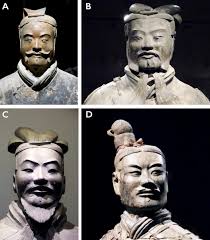
What Kind of Art is the Terracotta Army?
The Terracotta Army, an awe-inspiring collection of life-sized terracotta sculptures, stands as a testament to the artistic prowess of ancient China. Located in the Wei River Valley of Northwest China, the Terracotta Army represents a unique and groundbreaking form of art that distinguishes itself from Western artistic traditions, particularly Greek art.
A Material Advantage: Earth and Fire
The genesis of the Terracotta Army's unique artistic style lies in the abundant natural resources of its surrounding environment. The Wei River Valley is blessed with vast reserves of loess, a fertile, yellowish-brown soil. This readily available material provided the Qin artisans with an ideal medium for their artistic endeavors. Unlike the hard, unforgiving stone favored by Greek sculptors, loess offered malleability and ease of manipulation, allowing for the creation of intricate details and lifelike features. The process involved shaping the loess, firing it in kilns, and then meticulously painting the figures with vibrant pigments. This marriage of earth and fire gave birth to a distinct art form – one that embraced the plasticity of clay and the transformative power of heat.
Sculpture vs. Carving: A Difference in Approach
While both Greek art and the art of the Terracotta Army share the goal of representing the human form, their approaches differ significantly. Greek art, particularly during its Classical and Hellenistic periods, is largely defined by its mastery of sculpture. Greek artists, using materials like marble and bronze, employed chisels and other tools to painstakingly carve away material, revealing the desired form within. This subtractive process demanded precision, control, and a deep understanding of human anatomy.
In contrast, the art of the Terracotta Army belongs to the realm of modeling and sculpting. Rather than removing material, Qin artisans built up forms by adding and shaping clay. This additive approach allowed for greater freedom and flexibility, enabling the creation of dynamic poses and flowing garments. The use of molds further enhanced efficiency, allowing for the production of a vast army of figures with individualized features.
The Challenge of Mediums: Clay vs. Marble
The choice of material significantly impacts the technical challenges and artistic possibilities inherent in any art form. Carving hard materials like marble demands exceptional skill and control. Every stroke of the chisel is irreversible, making errors difficult to correct. The sculptor must possess a keen eye for detail and an understanding of how light interacts with the polished surface of the stone.
On the other hand, sculpting with clay offers a more forgiving medium. Mistakes can be rectified, and the material readily lends itself to experimentation and expressive gestures. The plasticity of clay allowed the Qin artisans to capture a wider range of human emotions and movements in their figures. The life-size Terracotta Army warriors exhibit a striking realism, conveying a sense of individuality, personality, and even the potential for movement, a feat rarely achieved in stone sculpture on such a grand scale.
Q&A
1. What makes the artistic style of the Terracotta Army unique?
The Terracotta Army's uniqueness stems from its utilization of local loess, its additive sculpting techniques, and its departure from the carving techniques prevalent in Greek art. The use of clay allowed for greater flexibility and the depiction of intricate details and lifelike expressions, resulting in a distinct aesthetic that reflects the artistic innovations of ancient China.
2. How does the choice of material influence the difficulty of creating art?
The choice of material significantly impacts the technical demands of art creation. Carving hard materials like marble requires precision and control due to the irreversible nature of each chisel stroke. Sculpting with clay, however, allows for more flexibility and forgiveness, enabling artists to experiment and make adjustments as needed.
3. What can we learn about ancient Chinese art from the Terracotta Army?
The Terracotta Army reveals the advanced artistic skills and cultural values of ancient China. It demonstrates a mastery of large-scale sculptural production, a keen observation of human anatomy and emotion, and a belief in the importance of honoring the deceased in the afterlife. The army's unique artistic style distinguishes it from Western traditions, highlighting the diversity and richness of global art history.